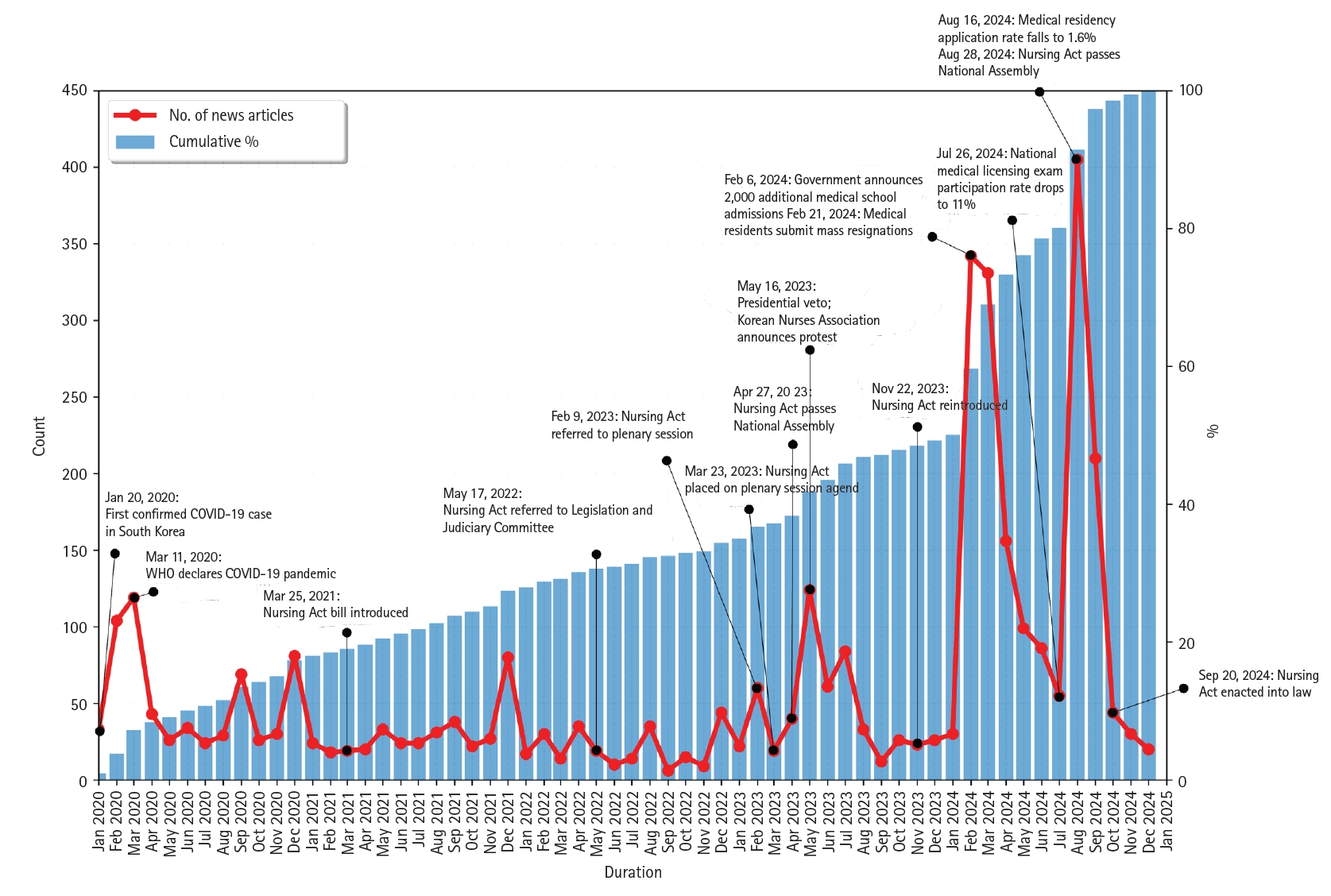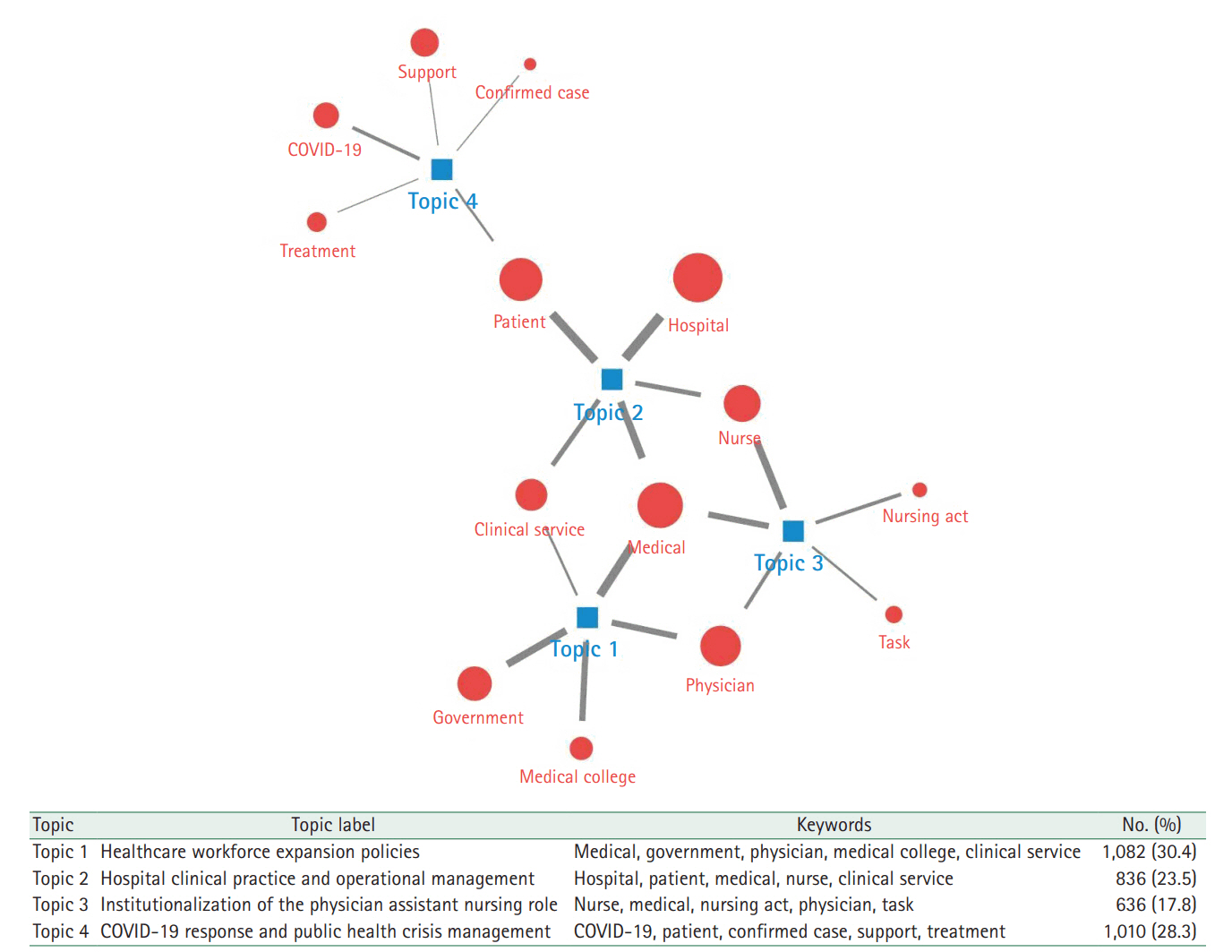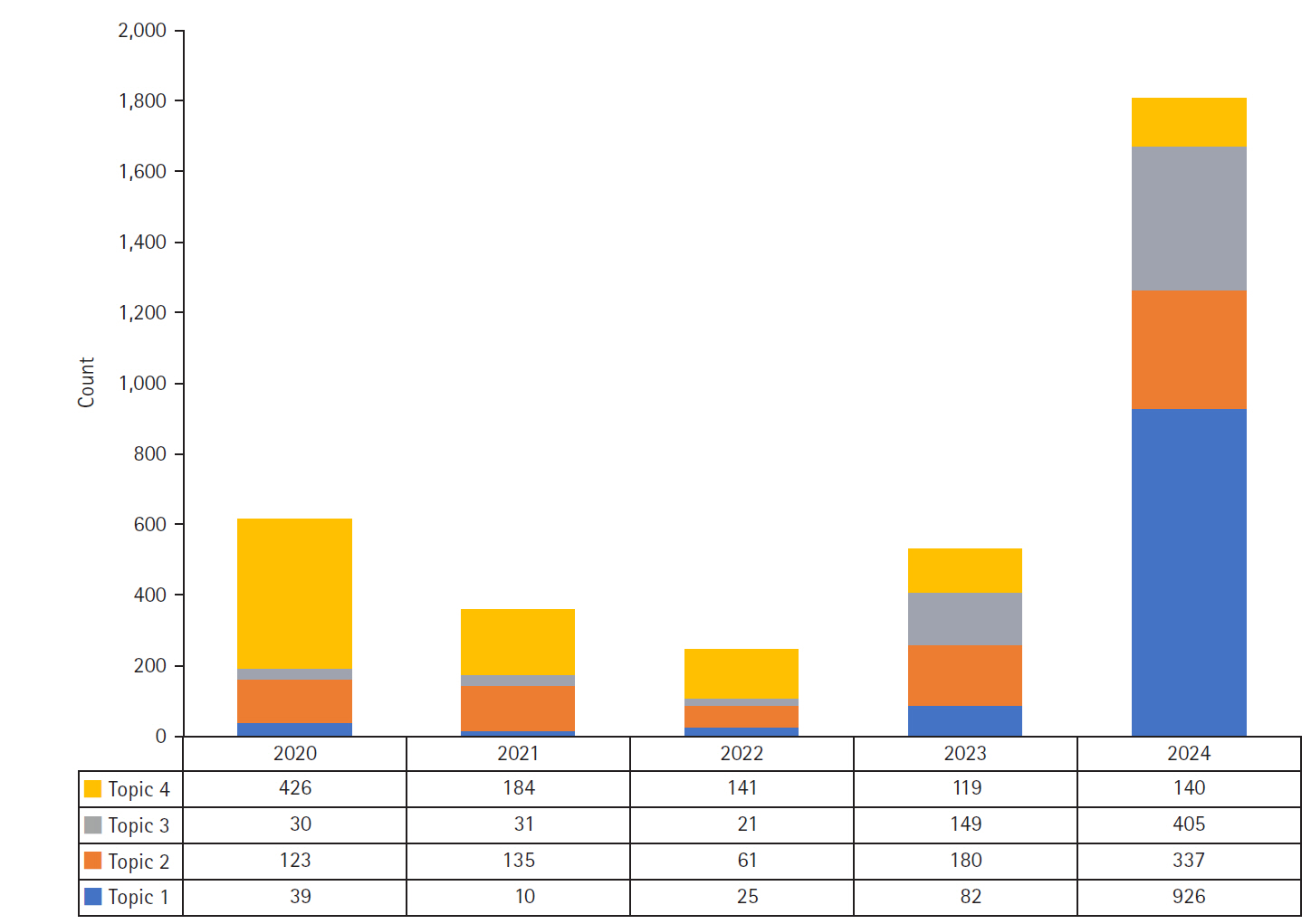Articles
- Page Path
- HOME > J Korean Acad Nurs > Volume 55(3); 2025 > Article
-
Research Paper
- Media discourse on physician assistant nurses in South Korea: a text network and topic modeling approach
-
Young Gyu Kwon1
 , Daun Jeong2,3
, Daun Jeong2,3 , Song Hee Park4
, Song Hee Park4 , Mi Kyung Kim4,5
, Mi Kyung Kim4,5 , Chan Woong Kim1,2
, Chan Woong Kim1,2
-
Journal of Korean Academy of Nursing 2025;55(3):388-399.
DOI: https://doi.org/10.4040/jkan.25038
Published online: July 30, 2025
1Center for Chung-Ang Medical Education Resource Allocation (CAMERA), Chung-Ang University College of Medicine, Seoul, Korea
2Department of Emergency Medicine, Chung-Ang University College of Medicine, Seoul, Korea
3Division of Critical Care Medicine, Department of Emergency Medicine, Chung-Ang University Gwangmyeong Hospital, Gwangmyeong, Korea
4Department of Medical Education, Chung-Ang University College of Medicine, Seoul, Korea
5Department of Pathology, Chung-Ang University College of Medicine, Seoul, Korea
- Corresponding author: Chan Woong Kim Center for Chung-Ang Medical Education Resource Allocation (CAMERA) and Department of Emergency Medicine, Chung-Ang University College of Medicine, 84 Heukseok-ro, Dongjak-gu, Seoul 06974, Korea E-mail: whenever@cau.ac.kr
© 2025 Korean Society of Nursing Science
This is an Open Access article distributed under the terms of the Creative Commons Attribution NoDerivs License (http://creativecommons.org/licenses/by-nd/4.0) If the original work is properly cited and retained without any modification or reproduction, it can be used and re-distributed in any format and medium.
- 3,231 Views
- 101 Download
Abstract
-
Purpose
- This study quantitatively examined the portrayal of physician assistant (PA) nurses in Korean media by integrating text network analysis with latent Dirichlet allocation (LDA) topic modeling.
-
Methods
- A total of 3,564 news articles published by nine major Korean media outlets between 2020 and 2024 were analyzed. Content analysis was conducted using term frequency-inverse document frequency calculations, network centrality analysis, and LDA topic modeling to extract key terms, map discourse structures, and identify latent topics.
-
Results
- The analysis identified four primary topics in Korean media discourse: “healthcare workforce expansion policies” (30.4%), “hospital clinical practice and operational management” (23.5%), “institutionalization of the PA nursing role” (17.8%), and “COVID-19 response and public health crisis management” (28.3%). High-centrality keywords included “hospital,” “medical,” “patient,” “physician,” “government,” and “nurse,” indicating that the discourse primarily focused on clinical settings. Topic modeling revealed a major shift from pandemic-centered coverage in 2020 to a focus on healthcare workforce policy and PA nurse institutionalization in 2024, coinciding with the passage of the Nursing Act.
-
Conclusion
- This study provides empirical evidence suggesting that the portrayal of PA nurses in Korean media discourse evolved from a peripheral regulatory issue to a central healthcare delivery solution, particularly in the contexts of workforce management, clinical practice, and crisis response. Our findings suggest that PA nurse institutionalization received broader attention when positioned as part of systemic healthcare improvements addressing concrete clinical needs. These results offer valuable insights for policymakers and administrators in framing and implementing workforce policy reforms.
Introduction
Methods
1) Keyword selection and data preprocessing
2) Term frequency and term frequency-inverse document frequency
3) Centrality analysis
4) Topic modeling
5) Analytical validation process
Results
1) Centrality analysis
1) Topic modeling analysis of media coverage on PA nurses
2) Topic trends by year
Discussion
Conclusion
-
Conflicts of Interest
No potential conflict of interest relevant to this article was reported.
-
Acknowledgements
None.
-
Funding
This research received no external funding
-
Data Sharing Statement
Please contact the corresponding author for data availability.
-
Supplementary Data
Supplementary data to this article can be found online at https://doi.org/10.15441/jkan.25038.
Supplementary Table 1. Compound terms
jkan-25038-Supplementary-Table-1.xlsx
Supplementary Table 2. Synonym categories
jkan-25038-Supplementary-Table-2.xlsx
Supplementary Table 3. Exclusion words
-
Author Contributions
Conceptualization and/or Methodology: YGK, DJ, SHP, CWK. Data curation and/or Analysis: YGK, DJ. Funding acquisition: none. Investigation: none. Project administration and/or Supervision: YGK, CWK. Resources and/or Software: YGK. Validation: YGK. Visualization: YGK. Writing: original draft and/or Review & Editing: YGK, DJ, SHP, MKK, CWK. Final approval of the manuscript: all authors.
Article Information
- 1. De Bruijn-Geraets DP, van Eijk-Hustings YJ, Bessems-Beks MC, Essers BA, Dirksen CD, Vrijhoef HJ, et al. National mixed methods evaluation of the effects of removing legal barriers to full practice authority of Dutch nurse practitioners and physician assistants. BMJ Open. 2018;8(6):e019962. https://doi.org/10.1136/bmjopen-2017-019962ArticlePubMedPMC
- 2. Jones CH, Dolsten M. Healthcare on the brink: navigating the challenges of an aging society in the United States. NPJ Aging. 2024;10(1):22. https://doi.org/10.1038/s41514-024-00148-2ArticlePubMedPMC
- 3. Cha S. South Korean doctors strike over plan to boost medical student numbers. Reuters [Internet]. 2020 Aug 7 [cited 2024 Oct 10]. Available from: https://www.reuters.com/article/business/healthcare-pharmaceuticals/skorean-doctors-strike-over-plan-to-boost-medical-student-numbers-idUSL4N2F8262
- 4. Huh S. The new placement of 2,000 entrants at Korean medical schools in 2025: is the government’s policy evidence-based? Ewha Med J. 2024;47(2):e13. https://doi.org/10.12771/emj.2024.e13Article
- 5. Park H. Junior doctors’ strike in South Korea: systemic barriers undermine medical practice. BMJ. 2024;385:q752. https://doi.org/10.1136/bmj.q752ArticlePubMed
- 6. Yoon JH, Kwon IH, Park HW. The South Korean health-care system in crisis. Lancet. 2024;403(10444):2589. https://doi.org/10.1016/S0140-6736(24)00766-9Article
- 7. Jun JH. Nurses allowed to perform CPR on emergency patients as trainee doctors’ walkout continues. Korea Times [Internet]. 2024 Mar 8 [cited 2024 Oct 10]. Available from: https://www.koreatimes.co.kr/www/nation/2025/02/113_370212.html
- 8. Choi SJ, Kim MY. Legal and practical solutions for the expanding the roles of medical support staff nurses. J Korean Acad Nurs. 2024;54(3):300-310. https://doi.org/10.4040/jkan.24075ArticlePubMed
- 9. Yoon SJ. A review and implication of international trends for the definition and scope of physician assistant. Glob Soc Secur Rev. 2022;(20):5-16. https://doi.org/10.23063/2022.03.1Article
- 10. Park HJ. Topic modeling analysis of news articles related to the legalization of physician assistants (PAs) nurses. Korean J Converg Sci. 2024;13(12):519-536. https://doi.org/10.24826/KSCS.13.12.31Article
- 11. Zhao W, Chen JJ, Perkins R, Liu Z, Ge W, Ding Y, et al. A heuristic approach to determine an appropriate number of topics in topic modeling. BMC Bioinformatics. 2015;16(Suppl 13):S8. https://doi.org/10.1186/1471-2105-16-S13-S8Article
- 12. Hassani H, Beneki C, Unger S, Mazinani MT, Yeganegi MR. Text mining in big data analytics. Big Data Cogn Comput. 2020;4(1):1. https://doi.org/10.3390/bdcc4010001Article
- 13. Jelodar H, Wang Y, Yuan C, Feng X, Jiang X, Li Y, et al. Latent Dirichlet allocation (LDA) and topic modeling: models, applications, a survey. Multimed Tools Appl. 2019;78(11):15169-15211. https://doi.org/10.1007/s11042-018-6894-4Article
- 14. Lee T, Kang KH, Ko YK, Cho SH, Kim EY. Issues and challenges of nurse workforce policy: a critical review and implication. J Korean Acad Nurs Adm. 2014;20(1):106-116. https://doi.org/10.11111/jkana.2014.20.1.106Article
- 15. Shin S, Park JD, Shin JH. Improvement plan of nurse staffing standards in Korea. Asian Nurs Res (Korean Soc Nurs Sci). 2020;14(2):57-65. https://doi.org/10.1016/j.anr.2020.03.004ArticlePubMed
- 16. Lee J, Chang HE, Cho J, Yoo S, Hyeon J. Analysis of issues related to nursing law: examination of news articles using topic modeling. PLoS One. 2024;19(8):e0308065. https://doi.org/10.1371/journal.pone.0308065ArticlePubMedPMC
- 17. Park D, Kim D, Park AH. Agendas on nursing in South Korea media: natural language processing and network analysis of news from 2005 to 2022. J Med Internet Res. 2024;26:e50518. https://doi.org/10.2196/50518ArticlePubMedPMC
- 18. Kwon YG, Namgung M, Park SH, Kim MK, Yoo HH, Kim CW, et al. Medical students’ perceptions of improving physician satisfaction and patient care: a text network analysis approach. BMC Med Educ. 2024;24(1):1549. https://doi.org/10.1186/s12909-024-06406-xArticlePubMedPMC
- 19. Qaiser S, Ali R. Text mining: use of TF-IDF to examine the relevance of words to documents. Int J Comput Appl. 2018;181(1):25-29. https://doi.org/10.5120/ijca2018917395Article
- 20. Jiang Z, Gao B, He Y, Han Y, Doyle P, Zhu Q. Text classification using novel term weighting scheme-based improved TF-IDF for internet media reports. Math Probl Eng. 2021;2021:6619088. https://doi.org/10.1155/2021/6619088Article
- 21. Borgatti SP, Everett MG. Network analysis of 2-mode data. Soc Networks. 1997;19(3):243-269. https://doi.org/10.1016/S0378-8733(96)00301-2Article
- 22. Chen X, Liu H. Using syntactic network characteristics to do text clustering. J Comput Eng Appl [Internet]. 2013 [cited 2024 Oct 10];49(8):32-36. Available from: https://www.researchgate.net/publication/317175489
- 23. Celardo L, Everett MG. Network text analysis: a two-way classification approach. Int J Inf Manage. 2020;51:102009. https://doi.org/10.1016/j.ijinfomgt.2019.09.005Article
- 24. Bloch F, Jackson MO, Tebaldi P. Centrality measures in networks. Soc Choice Welf. 2023;61(2):413-453. https://doi.org/10.1007/s00355-023-01456-4Article
- 25. Kretinin M, Nguyen G. Topic modeling on news articles using latent Dirichlet allocation. editors. Proceedings of the 2022 IEEE 26th International Conference on Intelligent Engineering Systems (INES); 2022 Aug 12-15; Crete, Greece. IEEE; 2022. p. 249-254. https://doi.org/10.1109/INES56734.2022.9922609Article
- 26. Greene D, O'Callaghan D, Cunningham P. How many topics?: stability analysis for topic models. In: Calders T, Esposito F, Hüllermeier E, Meo R, editors. Machine learning and knowledge discovery in databases. Springer; 2014. p. 498-513. https://doi.org/10.1007/978-3-662-44848-9_32
- 27. O'Callaghan D, Greene D, Carthy J, Cunningham P. An analysis of the coherence of descriptors in topic modeling. Expert Syst Appl. 2015;42(13):5645-5657. https://doi.org/10.1016/j.eswa.2015.02.055Article
- 28. Ding R, Nallapati R, Xiang B. Coherence-aware neural topic modeling. In: Riloff E, Chiang D, Hockenmaier J, Tsujii J, editors. Proceedings of the 2018 Conference on Empirical Methods in Natural Language Processing; 2018 Oct 31-Nov 4; Brussels, Belgium. Association for Computational Linguistics; 2018. p. 830-836. https://doi.org/10.18653/v1/D18-1096
- 29. Lin XL, Tan SW, Wang HY, Ang KH, Maniya S, Woo BF, et al. Healthcare professionals’ perspectives towards the role of ward-based advanced practice nurses: a cross-sectional study. J Adv Nurs. 2025;81(6):3083-3095. https://doi.org/10.1111/jan.16401ArticlePubMed
- 30. Maier CB, Aiken LH. Task shifting from physicians to nurses in primary care in 39 countries: a cross-country comparative study. Eur J Public Health. 2016;26(6):927-934. https://doi.org/10.1093/eurpub/ckw098ArticlePubMed
- 31. Boniol M, Kunjumen T, Nair TS, Siyam A, Campbell J, Diallo K, et al. The global health workforce stock and distribution in 2020 and 2030: a threat to equity and ‘universal’ health coverage? BMJ Glob Health. 2022;7(6):e009316. https://doi.org/10.1136/bmjgh-2022-009316ArticlePubMedPMC
- 32. World Health Organization (WHO). Nursing and midwifery [Internet]. WHO; 2024 [cited 2024 Oct 10]. Available from: https://www.who.int/news-room/fact-sheets/detail/nursing-and-midwifery
- 33. Richard E, Vandentorren S, Cambon L. Conditions for the success and the feasibility of health mediation for healthcare use by underserved populations: a scoping review. BMJ Open. 2022;12(9):e062051. https://doi.org/10.1136/bmjopen-2022-062051ArticlePubMedPMC
- 34. Bryant-Lukosius D, Dicenso A. A framework for the introduction and evaluation of advanced practice nursing roles. J Adv Nurs. 2004;48(5):530-540. https://doi.org/10.1111/j.1365-2648.2004.03235.xArticlePubMed
- 35. Kim N, Jung M. An analysis of media coverage and frame of the 2020 doctors strike. Health Soc Welf Rev. 2022;42(2):28-42. https://doi.org/10.15709/HSWR.2022.42.2.28Article
- 36. Prusaczyk B, Lenze E, Carpenter B, Morrow-Howell N. Leveraging disruptions to create an equitable, age-friendly, learning health system. Innov Aging. 2021;5(Suppl 1):290. https://doi.org/10.1093/geroni/igab046.1124Article
- 37. Do BS, Lee SB. What is emergency medicine and its agenda for future. Yeungnam Univ J Med. 2002;19(2):92-98. https://doi.org/10.12701/yujm.2002.19.2.92Article
- 38. Lee K, Lee S. Error-driven noun-connection rule extraction for morphological analysis. J Adv Mar Eng Technol. 2012;36(8):1123-1128. https://doi.org/10.5916/JKOSME.2012.36.8.1123Article
References
Figure & Data
REFERENCES
Citations




Fig. 1.
Fig. 2.
Fig. 3.
| Rank | TF |
TF-IDF |
||
|---|---|---|---|---|
| Keywords | Frequency | Keywords | Frequency | |
| 1 | Hospital | 22,605 | Workforce | 1,835 |
| 2 | Medical | 21,990 | Situation | 1,826 |
| 3 | Patient | 14,161 | Field | 1,608 |
| 4 | Physician | 12,828 | Need | 1,557 |
| 5 | Nurse | 11,149 | Task | 1,555 |
| 6 | Government | 10,115 | Medical college | 1,514 |
| 7 | Clinical service | 9,936 | Seoul | 1,495 |
| 8 | Support | 6,625 | Ministry of Health and Welfare | 1,452 |
| 9 | COVID-19 | 6,282 | Region | 1,429 |
| 10 | Medical college | 6,240 | Institution | 1,362 |
| 11 | Workforce | 5,420 | Operation | 1,360 |
| 12 | Treatment | 5,124 | Feasibility | 1,358 |
| 13 | Task | 4,865 | Public health | 1,349 |
| 14 | Region | 4,809 | Countermeasure | 1,305 |
| 15 | Situation | 4,556 | Treatment | 1,304 |
| 16 | Professor | 4,340 | Specialty | 1,276 |
| 17 | Resident | 4,034 | System | 1,270 |
| 18 | Specialty | 3,972 | Problem | 1,264 |
| 19 | Seoul | 3,821 | Health | 1,263 |
| 20 | Surgery | 3,658 | Nationwide | 1,249 |
| 21 | Field | 3,598 | Expertise | 1,240 |
| 22 | Emergency room | 3,593 | Abnormality | 1,237 |
| 23 | Need | 3,477 | Resident | 1,220 |
| 24 | Hospital bed | 3,474 | Public | 1,217 |
| 25 | Public | 3,473 | Physician assistant nurse | 1,203 |
| 26 | Center | 3,455 | Gap | 1,174 |
| 27 | Problem | 3,426 | Plan | 1,157 |
| 28 | Ministry of Health and Welfare | 3,396 | Surgery | 1,120 |
| 29 | Institution | 3,365 | Shortage | 1,116 |
| 30 | Medical staff | 3,281 | Medical staff | 1,103 |
| Rank | Keywords | Degree centrality | Keywords | Betweenness centrality |
|---|---|---|---|---|
| 1 | Hospital | .138 | Hospital | .111 |
| 2 | Medical | .121 | Medical | .078 |
| 3 | Patient | .101 | Patient | .059 |
| 4 | Physician | .100 | Physician | .053 |
| 5 | Government | .088 | Government | .041 |
| 6 | Nurse | .081 | Nurse | .037 |
| 7 | Clinical service | .068 | Support | .029 |
| 8 | Support | .064 | Medical college | .024 |
| 9 | Medical college | .053 | Professor | .022 |
| 10 | Professor | .052 | Region | .021 |
| 11 | Region | .052 | Clinical service | .020 |
| 12 | Treatment | .048 | Treatment | .017 |
| 13 | Need | .046 | Seoul | .017 |
| 14 | Medical staff | .046 | COVID-19 | .016 |
| 15 | Situation | .045 | Medical staff | .015 |
| 16 | COVID-19 | .044 | Center | .014 |
| 17 | Feasibility | .043 | Video | .014 |
| 18 | Public | .041 | Public | .013 |
| 19 | Operation | .040 | Surgery | .013 |
| 20 | Problem | .040 | Daegu | .012 |
| 21 | Center | .038 | Representative | .012 |
| 22 | Workforce | .038 | Situation | .012 |
| 23 | Task | .038 | Clinic | .012 |
| 24 | Field | .037 | Society | .011 |
| 25 | Surgery | .037 | South Korea | .011 |
| 26 | Specialty | .037 | Operation | .011 |
| 27 | Resident | .036 | Need | .011 |
| 28 | Ministry of Health and Welfare | .036 | Field | .011 |
| 29 | Emergency room | .035 | Feasibility | .010 |
| 30 | Society | .035 | Public health | .010 |
TF, term frequency; TF-IDF, term frequency-inverse document frequency.
 KSNS
KSNS
 E-SUBMISSION
E-SUBMISSION



 ePub Link
ePub Link Cite
Cite

